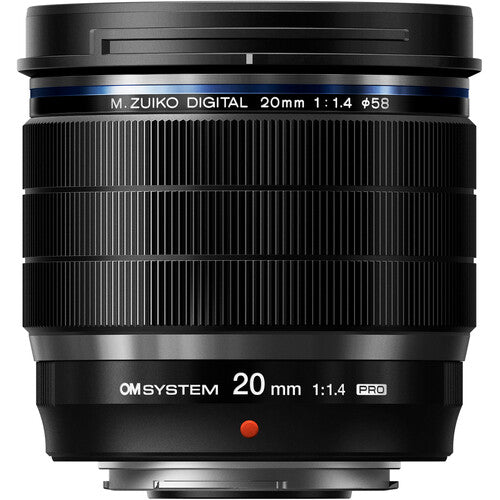What we think...
Product Description
OM System M.Zuiko Digital ED 20mm f1.4 PRO Lens
- Small and light
- Beautiful Feathered Bokeh
- Dust, splash and freezeproof
- Bright F1.4
- High Speed AF
- Lightweight, Compact Design
- Fluorine Coating
The versatile M.Zuiko Digital ED 20mm f/1.4 from OM SYSTEM is a 40mm equivalent wide-angle prime lens for Micro Four Thirds mirrorless cameras. The wide field of view is complemented by a fast f/1.4 maximum aperture for controlling depth of field and producing selective focus effects, when working in difficult lighting conditions.

This pocket-sized lens is easy to carry and balances high resolution with the ability to capture soft, feathered bokeh. This lens makes long days of shooting landscapes, nature, or travel photos seem effortless. Reliable IPX1-rated weather sealing makes it possible to shoot in any environmental conditions without worry. Two aspherical elements are used in the optical design to help reduce spherical aberrations in order to achieve a high degree of sharpness, and also help reduce the overall size and weight of the lens. The Movie & Still Compatible (MSC) autofocus system provides precise, fast, and quiet focus performance to suit both video and photo applications.

This wide-angle prime is designed for Micro Four Thirds mirrorless cameras and provides a 40mm equivalent focal length for 35mm format. It has a minimum focus distance of 9.8" for dynamic close-up imaging.
The fast f/1.4 maximum aperture can achieve shallow depth of field and selective focusing effects and when working in difficult lighting conditions. The rounded nine-blade diaphragm contributes to a pleasingly soft, feathered bokeh when shooting everything from nature to portraits.

Lens construction incorporates a sophisticated system of hermetic seals that lock out moisture, cold, and dust. The fully sealed splash, freeze, and dustproof design lends itself to use in a variety of locations and environments without the need for additional protective gear. It protects itself from harsh element and can continue to be used when the temperature dips down to down to -14°F / -10°C. When the lens is used with an Olympus splashproof body, IEC Standard publication 60529 IPX1 applies.

Two aspherical elements, three ED elements, one super ED element, and two Super HR elements are used to reduce spherical aberrations and distortions and optimize light transmission in order to provide increased sharpness and more accurate colour rendering.

ZERO (Zuiko Extra-Low Reflection Optical) coating provides reduced lens flare and optimal colour transmission.
Fluorine lens coating repels dust, dirt, rain, and snow from the front element for easy cleaning.
Movie & Still Compatible High Speed Imager (MSC) autofocus system benefits both photo and video applications due to its smooth, quiet, and fast performance.



























